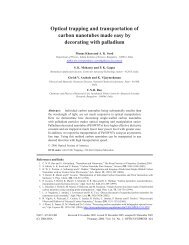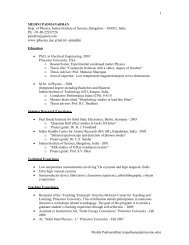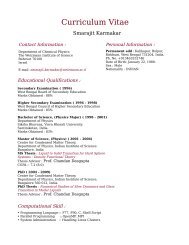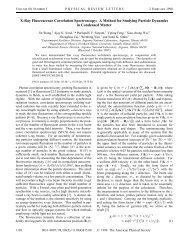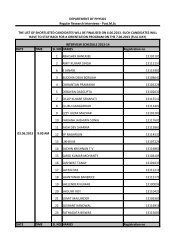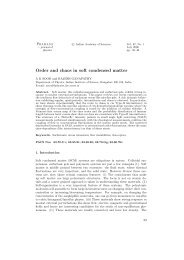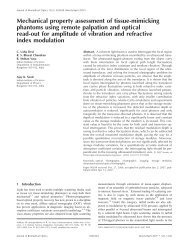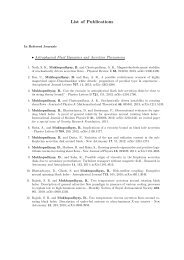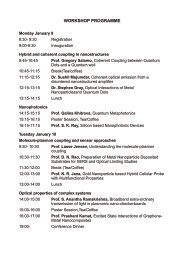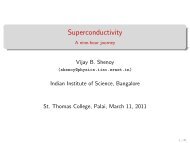Hydrodynamic Fluctuations and Instabilities in Ordered ... - Physics
Hydrodynamic Fluctuations and Instabilities in Ordered ... - Physics
Hydrodynamic Fluctuations and Instabilities in Ordered ... - Physics
You also want an ePaper? Increase the reach of your titles
YUMPU automatically turns print PDFs into web optimized ePapers that Google loves.
VOLUME 89, NUMBER 5 PHYSICAL REVIEW LETTERS 29JULY 2002<br />
<strong>Hydrodynamic</strong> <strong>Fluctuations</strong> <strong>and</strong> <strong>Instabilities</strong> <strong>in</strong> <strong>Ordered</strong> Suspensions of Self-Propelled Particles<br />
R. Aditi Simha* <strong>and</strong> Sriram Ramaswamy †<br />
Centre for Condensed-Matter Theory, Department of <strong>Physics</strong>, Indian Institute of Science, Bangalore 560 012, India<br />
(Received 18 August 2001; published 15 July 2002)<br />
We construct the hydrodynamic equations for suspensions of self-propelled particles (SPPs) with<br />
spontaneous orientational order, <strong>and</strong> make a number of strik<strong>in</strong>g, testable predictions: (i) Nematic SPP<br />
suspensions are always absolutely unstable at long wavelengths. (ii) SPP suspensions support novel<br />
propagat<strong>in</strong>g modes at long wavelengths, coupl<strong>in</strong>g orientation, flow, <strong>and</strong> concentration. (iii) In a wave<br />
number regime accessible only <strong>in</strong> low Reynolds number systems such as bacteria, polar-ordered<br />
suspensions are <strong>in</strong>variably convectively unstable. (iv) The variance <strong>in</strong> the number N of particles, divided<br />
by the mean hNi, diverges as hNi 2=3 <strong>in</strong> polar-ordered SPP suspensions.<br />
DOI: 10.1103/PhysRevLett.89.058101<br />
PACS numbers: 87.10.+e<br />
Fish, birds, <strong>and</strong> swimm<strong>in</strong>g cells [1–3] are frequently<br />
found to move coherently <strong>in</strong> large groups [4–9] through<br />
the fluid medium they <strong>in</strong>habit. Can general pr<strong>in</strong>ciples, like<br />
those used so successfully for ordered phases at equilibrium<br />
[10], reveal the laws govern<strong>in</strong>g the long-wavelength<br />
dynamics <strong>and</strong> fluctuations of these strik<strong>in</strong>g <strong>and</strong> ubiquitous<br />
examples of liquid-crystall<strong>in</strong>e [11] order <strong>in</strong> suspensions of<br />
self-propelled particles (SPPs)? Although we know of no<br />
physics experiments on ordered SPP suspensions, Gruler<br />
[12] has studied ordered phases of liv<strong>in</strong>g cells on a solid<br />
substrate, <strong>and</strong> f<strong>in</strong>ds ‘‘liv<strong>in</strong>g liquid-crystall<strong>in</strong>e’’ [13] phases<br />
correspond<strong>in</strong>g to two dist<strong>in</strong>ct types of cells: apolar, that is,<br />
elongated but head-tail symmetric, <strong>and</strong> polar, dist<strong>in</strong>guish<strong>in</strong>g<br />
front from rear. The ordered phases formed by polar<br />
SPPs have a nonzero macroscopic drift velocity v 0 . Those<br />
formed by apolar SPPs have a macroscopic axis ^n of<br />
orientation but, like true nematics [14], do not dist<strong>in</strong>guish<br />
^n from ^n; they thus have v 0 0. Migratory cells such as<br />
white blood cells are polar <strong>in</strong> this sense, while melanocytes,<br />
which distribute pigment <strong>in</strong> the sk<strong>in</strong>, are apolar [12].<br />
Although an isolated melanocyte is <strong>in</strong>capable of directed<br />
motion, we still term it an SPP because it displays spontaneous,<br />
self-generated energy-dissipat<strong>in</strong>g activity, <strong>in</strong> the<br />
form of a pair of symmetrically pulsat<strong>in</strong>g dendrites [12].<br />
The pioneer<strong>in</strong>g studies of [5] <strong>and</strong> [6,8,9] consider ordered<br />
flocks drift<strong>in</strong>g through a passive frictional background. In<br />
[7] as well, fluid flow is ignored <strong>in</strong> the analysis, although<br />
viscosity is mentioned as the source of damp<strong>in</strong>g. This is<br />
appropriate for polar SPPs on a substrate as <strong>in</strong> [12], but not<br />
for SPPs immersed <strong>in</strong> a bulk fluid. In this Letter we use<br />
symmetry <strong>and</strong> conservation laws to construct the complete<br />
equations of motion for small, long-wavelength disturbances<br />
<strong>in</strong> polar as well as apolar ordered SPP suspensions,<br />
<strong>in</strong>clud<strong>in</strong>g the flow of the ambient fluid.<br />
Our ma<strong>in</strong> results, which we now summarize, conta<strong>in</strong><br />
strik<strong>in</strong>g, experimentally testable signatures of the nonequilibrium<br />
nature of ordered SPP suspensions, <strong>and</strong> of the<br />
crucial role of the hydrodynamics of the ambient fluid<br />
medium: Purely nematic order <strong>in</strong> SPP suspensions is always<br />
destabilized at small enough wave number q, bya<br />
coupled splay of the axis of orientation <strong>and</strong> a correspond<strong>in</strong>g<br />
Taylor-Couette–like circulation of the velocity field,<br />
oriented near 45 to the nematic axis, with a growth rate<br />
l<strong>in</strong>ear <strong>in</strong> q.<br />
Polar ordered suspensions display some rather orig<strong>in</strong>al<br />
propagat<strong>in</strong>g modes as a result of the <strong>in</strong>terplay of hydrodynamic<br />
flow with fluctuations <strong>in</strong> the order<strong>in</strong>g direction<br />
<strong>and</strong> the concentration: a pair of bend-twist waves (with no<br />
analog <strong>in</strong> the work of [9]), with wave speeds; see Fig. 1 <strong>and</strong><br />
Eq. (7), <strong>and</strong> three waves which are a comb<strong>in</strong>ation of splay,<br />
concentration, <strong>and</strong> drift (a generalization of those <strong>in</strong> [9]),<br />
whose speeds are better understood from Fig. 2 than from<br />
an equation.<br />
The results <strong>in</strong> Figs. 1 <strong>and</strong> 2 <strong>and</strong> Eq. (7) are obta<strong>in</strong>ed<br />
when viscous damp<strong>in</strong>g is neglected, which is valid for<br />
wave numbers q v 0 = where is a typical k<strong>in</strong>ematic<br />
viscosity. Experiments on bacterial suspensions are, however,<br />
likely to be <strong>in</strong> the Re qa 1 regime, where Re<br />
v 0 a= is the Reynolds number of an SPP of size a. In that<br />
(Stokesian) limit we f<strong>in</strong>d, remarkably, that a polar-ordered<br />
suspension is always unstable for wave vectors q near 45<br />
to the nematic axis, with a growth rate v 0 =a, <strong>in</strong>dependent<br />
of jqj. The <strong>in</strong>stability is ‘‘convective’’: it travels with a<br />
speed v 0 as it grows.<br />
Last, number fluctuations <strong>in</strong> polar-ordered SPP suspensions<br />
are anomalously large. The variance h N 2 i <strong>in</strong> the<br />
number of particles, scaled by the mean N, is predicted to<br />
diverge as N 2=3 .<br />
The results above follow from a set of hydrodynamic<br />
equations of motion, which we now construct by generaliz<strong>in</strong>g<br />
[10]. Assume we have nematic or polar-ordered<br />
phases of SPPs, with orientation given by a unit director<br />
field ^n aligned on average <strong>in</strong> the z direction. The nematic is<br />
<strong>in</strong>variant under ^n ! ^n; the polar-ordered state is not.<br />
The slow variables [10] are (a) the ‘‘conserved modes’’<br />
which, for an <strong>in</strong>compressible suspension, are [15] the fluctuations<br />
c r;t at po<strong>in</strong>t r <strong>and</strong> time t <strong>in</strong> the local concentration<br />
c of suspended particles about its mean c 0 <strong>and</strong> the<br />
total (solute solvent) momentum density g r;t<br />
u r;t , where is the constant mass density of the<br />
suspension <strong>and</strong> u the hydrodynamic velocity field; <strong>and</strong><br />
(b) the ‘‘broken-symmetry’’ variables which, for both<br />
058101-1 0031-9007=02=89(5)=058101(4)$20.00 © 2002 The American Physical Society 058101-1
VOLUME 89, NUMBER 5 PHYSICAL REVIEW LETTERS 29JULY 2002<br />
0.8<br />
1.4<br />
0.6<br />
0.4<br />
0.2<br />
θ<br />
c bt1<br />
c bt2<br />
1.2<br />
1<br />
0.8<br />
0.6<br />
0.4<br />
0.2<br />
c s3<br />
θ<br />
c s1<br />
c s2<br />
c s3<br />
0<br />
0 0.1 0.2 0.3 0.4<br />
Sound speed ( <strong>in</strong> units of v 0<br />
)<br />
FIG. 1. A polar plot of speed of the bend-twist modes as a<br />
function of the angle between the propagation direction <strong>and</strong><br />
the z axis.<br />
polar <strong>and</strong> nematic phases, are simply the deviations n ?<br />
^n ^z. In polar-ordered suspensions, the drift velocity of<br />
SPPs relative to the fluid is v 0 ^n. S<strong>in</strong>ce these are driven<br />
systems, the forces enter<strong>in</strong>g the equations of motion need<br />
not arise from a free-energy functional, <strong>and</strong> any term not<br />
explicitly forbidden by symmetry or conservation laws<br />
must be <strong>in</strong>cluded. Moreover, there are a priori no relations<br />
among the phenomenological parameters other than those<br />
0<br />
0 0.2 0.4 0.6 0.8 1<br />
Sound speed ( <strong>in</strong> units of v ) 0<br />
FIG. 2. A polar plot of the speed of the splay-concentration <strong>and</strong><br />
drift waves as a function of the angle between the propagation<br />
direction <strong>and</strong> the z axis.<br />
required by the geometrical symmetries of the problem.<br />
Note that our coarse-gra<strong>in</strong>ed description applies on length<br />
scales a, the particle size.<br />
We now present the equations of motion which follow<br />
from these arguments, <strong>and</strong> expla<strong>in</strong> the physical orig<strong>in</strong> of<br />
the terms there<strong>in</strong>. We beg<strong>in</strong> with the polar-ordered case.<br />
The equations for the nematic case follow by dropp<strong>in</strong>g<br />
terms which violate z ! z symmetry. The director field<br />
obeys<br />
1<br />
@ t n ? 1 v 0 @ z n ? 1 r ? c<br />
2 @ 1<br />
zu ? r ? u z<br />
2 2 @ z u ? r ? u z ... (1)<br />
The first term on the right-h<strong>and</strong> side of (1) represents<br />
advection of distortions by the mean drift v 0 [16]. The<br />
second says simply that SPPs move from high to low result of the self-propell<strong>in</strong>g activity. We must allow for<br />
concentration—a nonequilibrium ‘‘osmotic pressure.’’ such a term because no symmetry can rule it out <strong>in</strong> these<br />
These terms are a consequence of the lack of z ! z<br />
symmetry, <strong>and</strong> are present <strong>in</strong> the model of [6,8,9] as<br />
well. The third term on the right says that <strong>in</strong> the absence<br />
of other forces the director rotates at the same rate as the<br />
fluid. Together with the fourth term, conta<strong>in</strong><strong>in</strong>g the phenomenological<br />
parameter 2, this gives rise to the ‘‘flowalignment’’<br />
[14,17] phenomenon, well-known <strong>in</strong> nematic<br />
hydrodynamics. These two terms are, of course, absent <strong>in</strong><br />
[6,8,9] <strong>and</strong> are central to our work. The ellipsis <strong>in</strong> (1)<br />
subsumes diffusive terms of higher order <strong>in</strong> gradients, as<br />
well as nonl<strong>in</strong>ear terms.<br />
The equation of motion for g has the form @ t g i<br />
r j<br />
ij , as <strong>in</strong> any momentum-conserv<strong>in</strong>g system, where<br />
ij is the stress tensor. What dist<strong>in</strong>guishes SPP systems is a<br />
p<br />
contribution ij / n i n j 1=3 ij to the shear stress, as a<br />
driven systems [18]. To derive from the dynamics of<br />
<strong>in</strong>dividual SPPs note that, by Newton’s Third Law, the<br />
forces exerted by an SPP on the fluid <strong>and</strong> by the fluid on<br />
an SPP are equal <strong>and</strong> opposite; i.e., the comb<strong>in</strong>ed system of<br />
SPPs fluid is force-free. Thus, <strong>in</strong> the equation of motion<br />
for the total momentum density g, the force density associated<br />
with each SPP <strong>and</strong> the ambient fluid must <strong>in</strong>tegrate<br />
to zero. Averag<strong>in</strong>g over the detailed swimm<strong>in</strong>g movements,<br />
it follows that the simplest model for, say, the th<br />
SPP is a rod with axis ^n t , at time t, with po<strong>in</strong>t forces of<br />
equal magnitude f on its ends, directed along ^n [19].<br />
For a collection of SPPs with centers at r t <strong>and</strong> ends at<br />
r a ^n <strong>and</strong> r a 0 ^n , where we have allowed for force<br />
centers asymmetrically disposed about the center of the<br />
SPP, this yields a force density (divergence of stress)<br />
058101-2 058101-2<br />
p<br />
ij
VOLUME 89, NUMBER 5 PHYSICAL REVIEW LETTERS 29JULY 2002<br />
r<br />
p<br />
f p r;t<br />
f X ^n t f r r t a ^n t<br />
r r t a 0 ^n t g : (2)<br />
The apolar <strong>and</strong> polar SPPs we mentioned early <strong>in</strong> this<br />
Letter correspond, respectively, to a a 0 <strong>and</strong> a a 0 .<br />
Exp<strong>and</strong><strong>in</strong>g the delta functions <strong>in</strong> (2) about r gives<br />
f p<br />
i ’ a a0 X<br />
fr<br />
2 j ^n i ^n j r r O rr : (3)<br />
In a coarse-gra<strong>in</strong>ed description this clearly leads to a shear<br />
stress<br />
p a a 0<br />
1<br />
ij r;t fc r;t n<br />
2<br />
i n j<br />
3 ij O r (4)<br />
as claimed above. Note that only the sum a a 0 appears <strong>in</strong><br />
(4); to lead<strong>in</strong>g order <strong>in</strong> gradients, the self-propell<strong>in</strong>g stress<br />
is the same for polar <strong>and</strong> apolar phases. Us<strong>in</strong>g this stress <strong>in</strong><br />
the momentum equation @ t g i r j ij , Fourier transform<strong>in</strong>g<br />
<strong>in</strong> space, replac<strong>in</strong>g g by the hydrodynamic velocity<br />
field u g= , <strong>and</strong> project<strong>in</strong>g transverse to the wave<br />
vector q to impose <strong>in</strong>compressibility (r u 0 yields,<br />
after some algebra,<br />
@u ?<br />
@t<br />
iw 0 q z I 2 q ?q ?<br />
q 2 n ? i q2 z<br />
q 2 q ? c ...<br />
(5)<br />
where I is the unit tensor, <strong>and</strong> fa= <strong>and</strong> w 0 c 0 are<br />
phenomenological constants proportional to the activity of<br />
the SPPs. In (5), nematic-elastic torques [14] <strong>and</strong> viscous<br />
forces, both of which are subdom<strong>in</strong>ant at small q, have<br />
been ignored, as have <strong>in</strong>ertial <strong>and</strong> other nonl<strong>in</strong>earities. The<br />
pressurelike term despite transverse projection <strong>and</strong> the<br />
acceleration proportional to the bend q z n ? arise purely<br />
because of self-propulsion [18].<br />
Number conservation of SPPs implies @ t c r j,<br />
where the current j cv 0 ^n apart from advection by fluid<br />
flow <strong>and</strong> diffusion. To lowest order <strong>in</strong> gradients <strong>and</strong> fields,<br />
this tells us that<br />
@ t v 0 @ z c c 0 v 0 r ? n ? (6)<br />
which says the concentration changes by advection by the<br />
mean drift v 0 or by local splay (s<strong>in</strong>ce that implies a<br />
divergence <strong>in</strong> the local SPP velocity).<br />
We can now extract the propagat<strong>in</strong>g waves <strong>and</strong> <strong>in</strong>stabilities<br />
mentioned at the start of this paper, from the<br />
dispersion relation, frequency ! as a function of wave<br />
vector q, for modes vary<strong>in</strong>g as exp iq r i!t , implied<br />
by Eqs. (1), (5), <strong>and</strong> (6).<br />
Bend-twist waves: Tak<strong>in</strong>g the curl of (1) <strong>and</strong> (5) yields<br />
the coupled dynamics of bend or twist (r n ? ) <strong>and</strong><br />
vorticity (r u ? ). Fourier transform<strong>in</strong>g <strong>in</strong> space <strong>and</strong><br />
time yields ! c bt q, with wave speeds (see Fig. 1)<br />
c bt c 1 c 2 cos ; (7)<br />
where is the angle between the propagation vector <strong>and</strong><br />
the order<strong>in</strong>g direction, <strong>and</strong> c 1 <strong>and</strong> c 2 (of order the drift<br />
speed v 0 of the SPPs) are phenomenological constants.<br />
An analysis ignor<strong>in</strong>g hydrodynamic flow, as <strong>in</strong> [6,8,9],<br />
would <strong>in</strong>stead predict purely diffusive relaxation for bend<br />
<strong>and</strong> twist.<br />
Splay-concentration <strong>and</strong> drift waves: Tak<strong>in</strong>g the divergence<br />
of (1) <strong>and</strong> (5) results <strong>in</strong> coupled equations of motion<br />
for r n ? , r u ? , <strong>and</strong> c. The result<strong>in</strong>g wavelike eigenmodes<br />
are a generalization of those seen <strong>in</strong> [9]. Their<br />
speeds obey a messy cubic equation which, we can show<br />
[20], has real solutions for a f<strong>in</strong>ite range of parameter<br />
values. The speeds as functions of direction, for typical<br />
parameter values, are illustrated <strong>in</strong> Fig. 2.<br />
Viscous effects, <strong>and</strong> the <strong>in</strong>stability of polar SPP suspensions<br />
<strong>in</strong> the Stokesian limit: So far, we have ignored<br />
damp<strong>in</strong>g terms <strong>in</strong> the equations of motion s<strong>in</strong>ce they<br />
enter at next-to-lead<strong>in</strong>g order <strong>in</strong> wave number q. There<br />
are three types of such terms: (i) viscous damp<strong>in</strong>g q 2 u<br />
<strong>in</strong> the momentum equation (where is a typical k<strong>in</strong>ematic<br />
viscosity of the suspension); (ii) Dq 2 c <strong>in</strong> the concentration<br />
equation, D be<strong>in</strong>g a diffusivity; (iii) D n q 2 n ? <strong>in</strong> the<br />
director equation where D n is a director diffusivity which<br />
we expect to be comparable to D. In bacteria, diffusivities<br />
are of order 10 6 cm 2 =s [3] <strong>and</strong> can clearly be neglected<br />
relative to the viscosity. In large-Re systems such as fish,<br />
we have no reliable estimate of D, but it seems reasonable<br />
to assume it is no larger than . Accord<strong>in</strong>gly, when damp<strong>in</strong>g<br />
terms are <strong>in</strong>cluded, the modes will rema<strong>in</strong> propagat<strong>in</strong>g<br />
only for qa
VOLUME 89, NUMBER 5 PHYSICAL REVIEW LETTERS 29JULY 2002<br />
under z ! z, i.e., by sett<strong>in</strong>g v 0 1 0. This can<br />
readily be shown to yield the dispersion, ! 2<br />
Aq 2 cos2 2 cos2 1 , where jAj w 0 . Physically,<br />
this can be understood as follows. The nematic symmetry<br />
z ! z means that a distortion with wave vector at exactly<br />
45 has no wavelike response: it does not know which way<br />
to go, so the O q 2 contribution to the squared frequency<br />
! 2 q vanishes at this angle. ! 2 must thus change sign as<br />
crosses 45 .For =4 , where is small <strong>and</strong> has<br />
the p same sign as A, we thus get an <strong>in</strong>stability with ! q<br />
i j j q iq 2 . Here the last term appears when diffusive<br />
<strong>and</strong> viscous terms <strong>and</strong> the conventional nematic-elastic<br />
torques are <strong>in</strong>cluded, <strong>and</strong> will stabilize modes at larger<br />
wave number. For an SPP nematic on a substrate as <strong>in</strong> [12],<br />
a wave-number-<strong>in</strong>dependent damp<strong>in</strong>g enters the momentum<br />
Eq. (5) <strong>and</strong> <strong>in</strong> general suppresses this <strong>in</strong>stability [20].<br />
<strong>Fluctuations</strong>: In strik<strong>in</strong>g contrast to systems at thermal<br />
equilibrium, ordered suspensions of SPPs display giant<br />
number fluctuations. To see this, we must <strong>in</strong>clude noise,<br />
as well as the damp<strong>in</strong>g terms whose form we have discussed,<br />
<strong>in</strong> the equations of motion. For a general SPP<br />
suspension one expects noise sources of three k<strong>in</strong>ds: thermal<br />
Brownian motion (negligible for particles larger than a<br />
few microns), many-particle hydrodynamic <strong>in</strong>teractions,<br />
<strong>and</strong> <strong>in</strong>tr<strong>in</strong>sic fluctuations <strong>in</strong> the self-propell<strong>in</strong>g activity of<br />
<strong>in</strong>dividual SPPs. In our coarse-gra<strong>in</strong>ed description it is<br />
reasonable to assume Gaussian noise sources f u , f c , <strong>and</strong><br />
f n , delta correlated <strong>in</strong> time, <strong>in</strong> the equations of motion for<br />
u, c, <strong>and</strong> n. Momentum <strong>and</strong> number conservation imply<br />
variances q 2 for f u <strong>and</strong> f c for wave number q ! 0, <strong>and</strong><br />
nonzero for f n . With these noise <strong>and</strong> damp<strong>in</strong>g terms <strong>in</strong><br />
place we can calculate correlation functions of the various<br />
fields <strong>in</strong> theRsteady state. We f<strong>in</strong>d that the structure factor<br />
S q c0<br />
1<br />
r exp iq rh c 0 c r i 1=q2 , which implies<br />
that the variance of the number of particles, scaled by<br />
the mean, grows as L 2 N 2=3 for a three-dimensional<br />
region of l<strong>in</strong>ear size L conta<strong>in</strong><strong>in</strong>g N particles on average.<br />
Physically, this happens because distortions <strong>in</strong> the director<br />
produce mass flow. S<strong>in</strong>ce the director fluctuations—a<br />
broken-symmetry mode—are large, this results <strong>in</strong> giant<br />
number fluctuations as well. Similar supernormal number<br />
variances were predicted [6,8,9] for SPPs on a substrate; it<br />
is remarkable that they survive here <strong>in</strong> the presence of<br />
long-ranged hydrodynamic <strong>in</strong>teractions.<br />
Let us now estimate the numerical values of the effects<br />
we predict. All wave speeds are expected to be of order the<br />
drift speed of an SPP (from m=s to cm=s as one goes<br />
from bacteria to fish). If we take the k<strong>in</strong>ematic viscosity<br />
to be that of water, then the growth rate of the convectively<br />
unstable mode <strong>in</strong> Stokesian polar-ordered SPP suspensions,<br />
say, for bacteria (where velocities are 10 m=s,<br />
size a m, <strong>and</strong> a few percent), is 0:1 s 1 . We look<br />
forward to experimental tests of our predictions, on liv<strong>in</strong>g<br />
organisms or perhaps on artificial SPP suspensions.<br />
An analysis of the complete (not l<strong>in</strong>earized) equations of<br />
motion, now underway, will show how nonl<strong>in</strong>ear fluctuation<br />
effects renormalize the speeds <strong>and</strong> damp<strong>in</strong>gs of the<br />
modes presented here, <strong>and</strong> whether they alter the manner <strong>in</strong><br />
which number fluctuations diverge with size. The full<br />
equations of motion will also prove useful <strong>in</strong> underst<strong>and</strong><strong>in</strong>g<br />
the effect of imposed shear flows on the state of order<br />
of SPP suspensions, <strong>and</strong> the role of boundaries [21]<br />
<strong>and</strong> topological defects <strong>in</strong> these systems. These, as well<br />
as other results on SPP nematics on substrates <strong>and</strong> an<br />
analysis of isotropic SPP suspensions [3], will appear elsewhere<br />
[20].<br />
S. R. thanks the Aspen Center for <strong>Physics</strong> for support<br />
while part of this work was done.<br />
*Electronic address: aditi@physics. iisc.ernet.<strong>in</strong><br />
† Electronic address: sriram@physics.iisc.ernet.<strong>in</strong><br />
[1] J. Lighthill, SIAM Rev. 18, 161 (1976).<br />
[2] T. J. Pedley <strong>and</strong> J. O. Kessler, Annu. Rev. Fluid Mech. 24,<br />
313 (1992).<br />
[3] X.-L. Wu <strong>and</strong> A. Libchaber, Phys. Rev. Lett. 84, 3017<br />
(2000); G. Grégoire, H. Chaté, <strong>and</strong> Y. Tu, Phys. Rev. E 64,<br />
011902 (2001).<br />
[4] C. Reynolds, Comput. Graph. 21, 25 (1987); J.<br />
Deneubourg <strong>and</strong> S. Goss, Ethol. Ecol. Evolution 1, 29<br />
(1989); A. Huth <strong>and</strong> C. Wissel, <strong>in</strong> Biological Motion,<br />
edited by W. Alt <strong>and</strong> E. Hoffmann (Spr<strong>in</strong>ger-Verlag,<br />
New York, 1990); B. L. Partridge, Sci. Am. 246, No. 6,<br />
114 (1982).<br />
[5] T. Vicsek, A. Czirók, E. Ben-Jacob, I. Cohen, <strong>and</strong><br />
O. Shochet, Phys. Rev. Lett. 75, 1226 (1995).<br />
[6] J. Toner <strong>and</strong> Y. Tu, Phys. Rev. Lett. 75, 4326 (1995).<br />
[7] N. Shimoyama, K. Sugawara, T. Mizuguchi, Y. Hayakawa,<br />
<strong>and</strong> M. Sano, Phys. Rev. Lett. 76, 3870 (1996).<br />
[8] J. Toner <strong>and</strong> Y. Tu, Phys. Rev. Lett. 80, 4819 (1998).<br />
[9] J. Toner <strong>and</strong> Y. Tu, Phys. Rev. E 58, 4828 (1998).<br />
[10] P. C. Mart<strong>in</strong>, O. Parodi, <strong>and</strong> P. S. Pershan, Phys. Rev. A 6,<br />
2401 (1972); D. Forster, <strong>Hydrodynamic</strong> <strong>Fluctuations</strong>,<br />
Broken Symmetry, <strong>and</strong> Correlation Functions (Benjam<strong>in</strong>,<br />
Read<strong>in</strong>g, 1975).<br />
[11] Reference [9] suggests that crystall<strong>in</strong>e, translational order<br />
may be seen <strong>in</strong> flocks as well.<br />
[12] H. Gruler, U. Dewald, <strong>and</strong> M. Eberhardt, Eur. Phys. J. B<br />
11, 187 (1999); R. Kemkemer, D. Kl<strong>in</strong>g, D. Kaufmann,<br />
<strong>and</strong> H. Gruler, Eur. Phys. J. E 1, 215 (2000).<br />
[13] H. Gruler, M. Schienbe<strong>in</strong>, K. Franke, <strong>and</strong> A. deBoisfleury-<br />
Chevance, Mol. Cryst. Liq. Cryst. 260, 565 (1995).<br />
[14] P. G. de Gennes <strong>and</strong> J. Prost, The <strong>Physics</strong> of Liquid<br />
Crystals (Clarendon Press, Oxford, 1995).<br />
[15] We ignore heat diffusion, nutrient uptake, excretion, reproduction,<br />
<strong>and</strong> death.<br />
[16] As <strong>in</strong> [6,8,9], the speed of advection is not <strong>in</strong> general equal<br />
to the drift speed, hence the factor 1.<br />
[17] D. Forster, Phys. Rev. Lett. 32, 1161 (1974).<br />
[18] Such terms are ruled out <strong>in</strong> equilibrium nematics by the<br />
requirement that force densities arise from a free-energy<br />
functional via Poisson-bracket relations.<br />
[19] See J.-B. Manneville, P. Bassereau, S. Ramaswamy, <strong>and</strong><br />
J. Prost, Phys. Rev. E 64, 021908 (2001).<br />
[20] R. A. Simha <strong>and</strong> S. Ramaswamy (to be published).<br />
[21] Y. Tu, Physica (Amsterdam) 281A, 30–40 (2000).<br />
058101-4 058101-4



